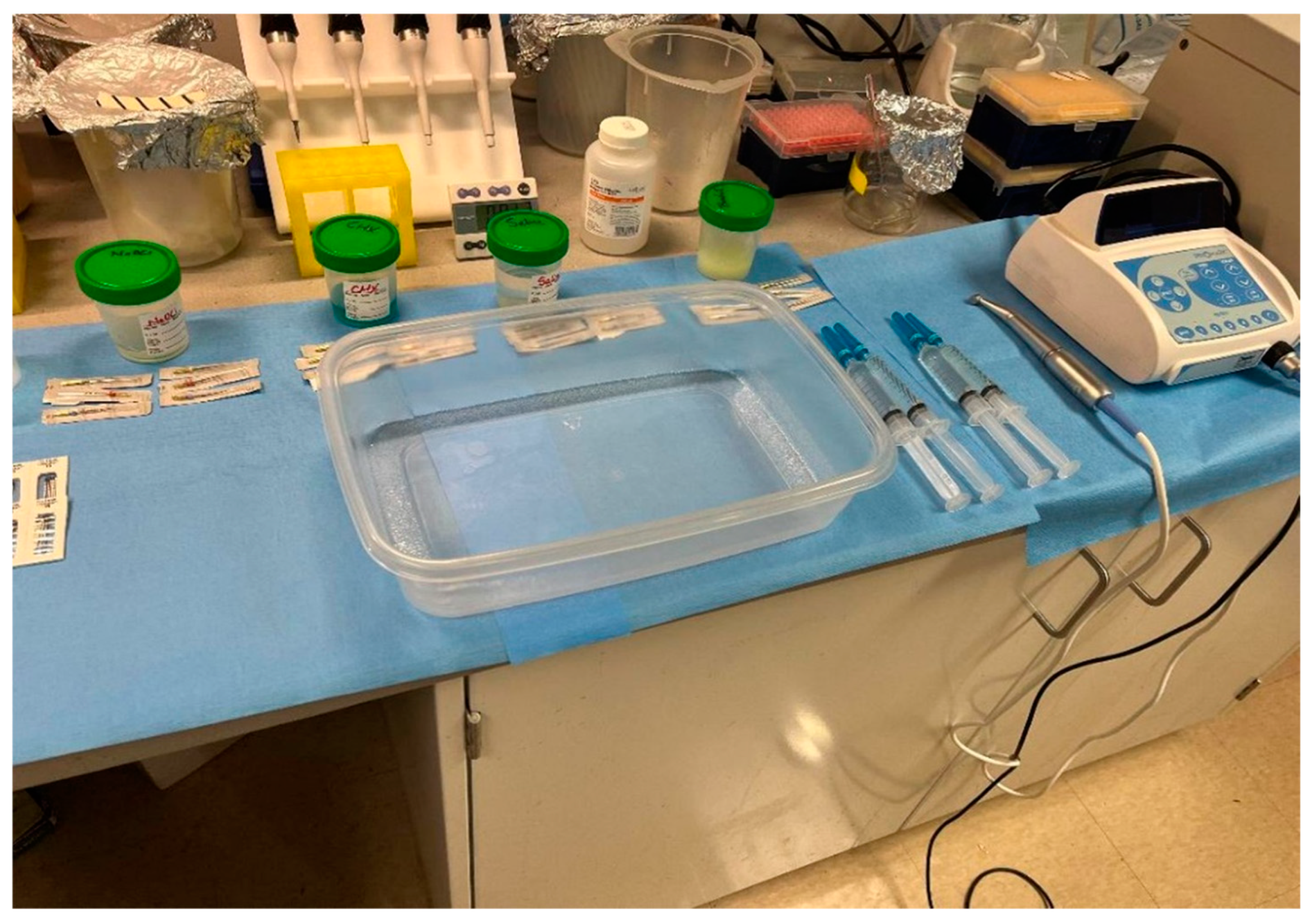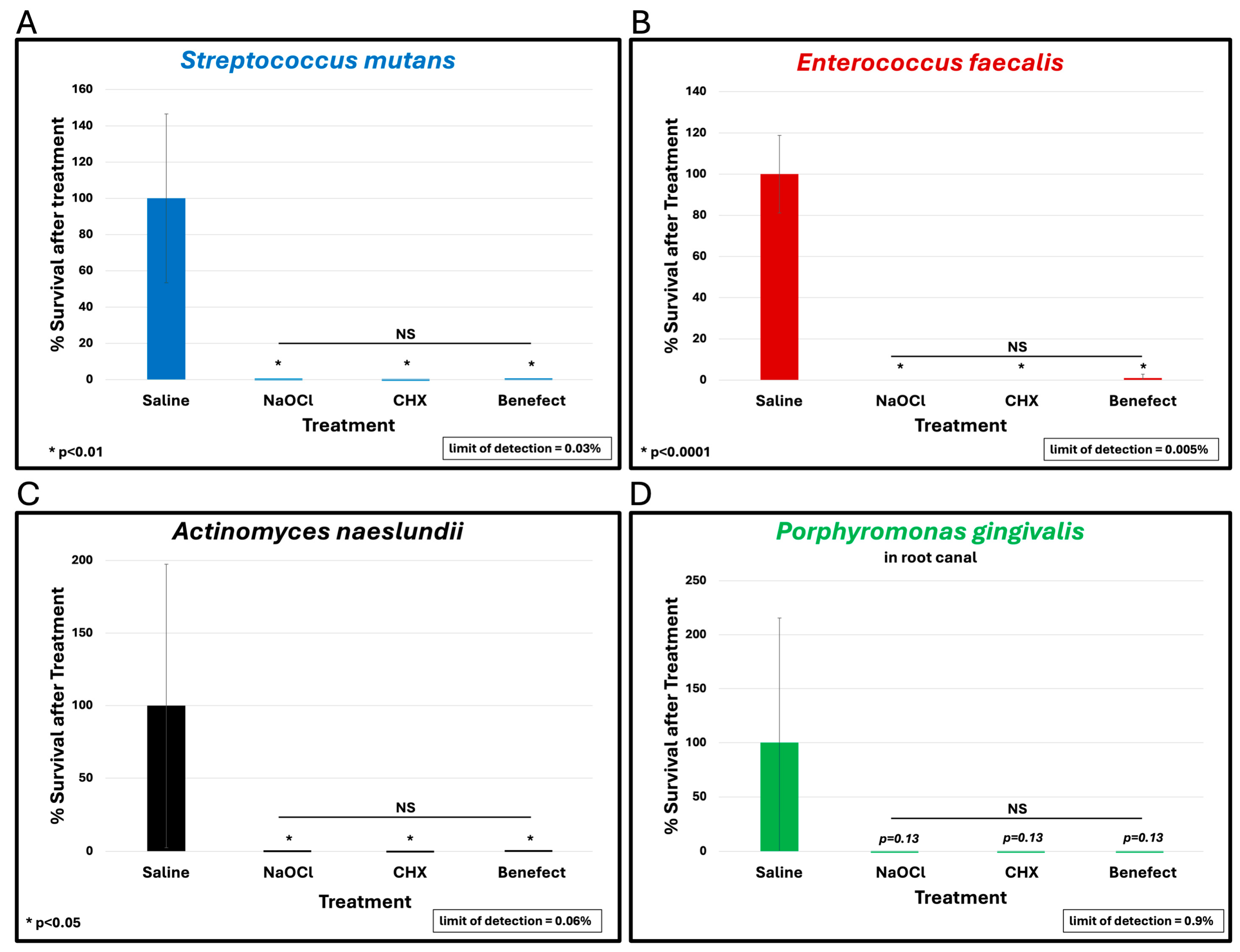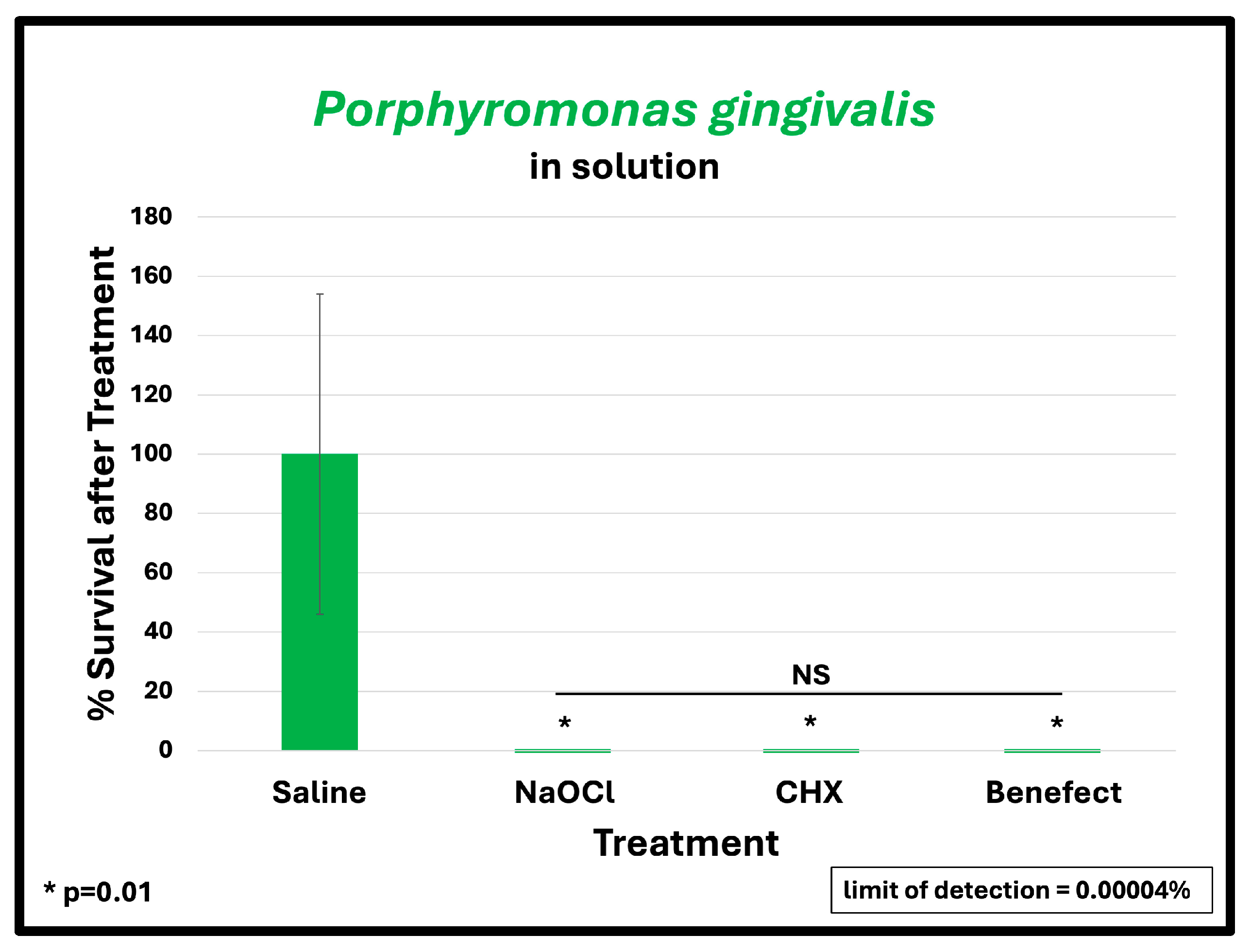Antibacterial Efficacy of Benefect™ Botanical Disinfectant in Comparison with Sodium Hypochlorite and Chlorohexidine Against Multiple Endodontic Pathogens: An Ex Vivo Study
Abstract
1. Introduction
2. Materials and Methods
2.1. Specimen Selection and Preparation
2.2. Sterilization and Asepsis Control
2.3. Root Canal Inoculation
2.4. Processing of Specimen Samples
2.5. Microbial Sampling and Bacterial Counting
2.6. Liquid Killing Assay
3. Results
4. Discussion
5. Conclusions
Author Contributions
Funding
Institutional Review Board Statement
Informed Consent Statement
Data Availability Statement
Acknowledgments
Conflicts of Interest
References
- Kakehashi, S.; Stanley, H.R.; Fitzgerald, R.J. The effects of surgical exposures of dental pulps in germ-free and conventional laboratory rats. Oral Surg. Oral Med. Oral Pathol. 1965, 20, 340–349. [Google Scholar] [CrossRef]
- Siqueira, J.F., Jr.; Rôças, I.N. Diversity of endodontic microbiota revisited. J. Dent. Res. 2009, 88, 969–981. [Google Scholar] [CrossRef]
- Singh, H. Microbiology of endodontic infections. J. Dent. Oral Health 2016, 2, 1–4. [Google Scholar]
- Siqueira, J.F., Jr. Endodontic infections: Concepts, paradigms, and perspectives. Oral Surg. Oral Med. Oral Pathol. Oral Radiol. Endod. 2002, 94, 281–293. [Google Scholar] [CrossRef]
- Siqueira, J.F., Jr.; Rôças, I.N. Exploiting molecular methods to explore endodontic infections: Part 2--Redefining the endodontic microbiota. J. Endod. 2005, 31, 488–498. [Google Scholar] [CrossRef]
- Pinheiro, E.T.; Gomes, B.P.; Ferraz, C.C.; Sousa, E.L.; Teixeira, F.B.; Souza-Filho, F.J. Microorganisms from canals of root-filled teeth with periapical lesions. Int. Endod. J. 2003, 36, 1–11. [Google Scholar] [CrossRef] [PubMed]
- Sakamoto, M.; Siqueira, J.F., Jr.; Rôças, I.N.; Benno, Y. Molecular analysis of the root canal microbiota associated with endodontic treatment failures. Oral Microbiol. Immunol. 2008, 23, 275–281. [Google Scholar] [CrossRef] [PubMed]
- Haapasalo, M.; Shen, Y. Current therapeutic options for endodontic biofilms. Endod. Top. 2010, 22, 79–98. [Google Scholar] [CrossRef]
- Zehnder, M. Root canal irrigants. J. Endod. 2006, 32, 389–398. [Google Scholar] [CrossRef] [PubMed]
- Hasselgren, G.; Olsson, B.; Cvek, M. Effects of calcium hydroxide and sodium hypochlorite on the dissolution of necrotic porcine muscle tissue. J. Endod. 1988, 14, 125–127. [Google Scholar] [CrossRef]
- Retamozo, B.; Shabahang, S.; Johnson, N.; Aprecio, R.M.; Torabinejad, M. Minimum contact time and concentration of sodium hypochlorite required to eliminate Enterococcus faecalis. J. Endod. 2010, 36, 520–523. [Google Scholar] [CrossRef] [PubMed]
- Marending, M.; Luder, H.U.; Brunner, T.J.; Knecht, S.; Stark, W.J.; Zehnder, M. Effect of sodium hypochlorite on human root dentine--mechanical, chemical and structural evaluation. Int. Endod. J. 2007, 40, 786–793. [Google Scholar] [CrossRef]
- Mohammadi, Z.; Abbott, P.V. The properties and applications of chlorhexidine in endodontics. Int. Endod. J. 2009, 42, 288–302. [Google Scholar] [CrossRef]
- Mohammadi, Z. Chlorhexidine gluconate, its properties and applications in endodontics. Iran Endod. J. 2008, 2, 113–125. [Google Scholar] [PubMed]
- Agarwal, S.; Piesco, N.P.; Peterson, D.E.; Charon, J.; Suzuki, J.B.; Godowski, K.C.; Southard, G.L. Effects of sanguinarium, chlorhexidine and tetracycline on neutrophil viability and functions in vitro. J. Periodontal Res. 1997, 32, 335–344. [Google Scholar] [CrossRef]
- Zaura-Arite, E.; van Marle, J.; Cate, J.T. Confocal Microscopy Study of Undisturbed and Chlorhexidine-treated Dental Biofilm. J. Dent. Res. 2001, 80, 1436–1440. [Google Scholar] [CrossRef]
- Almadi, E.M.; Almohaimede, A.A. Natural products in endodontics. Saudi Med. J. 2018, 39, 124–130. [Google Scholar] [CrossRef]
- Venkateshbabu, N.; Anand, S.; Abarajithan, M.; Sheriff, S.O.; Jacob, P.S.; Sonia, N. Natural Therapeutic Options in Endodontics—A Review. Open Dent. J. 2016, 10, 214–226. [Google Scholar] [CrossRef]
- Benefect TM Disinfectant Product Sheet. Available online: https://benefect.com/pdf/disinfectant-product-data-sheet-usa.pdf (accessed on 12 July 2023).
- Roger, P.; Delettre, J.; Bouix, M.; Béal, C. Characterization of Streptococcus salivarius growth and maintenance in artificial saliva. J. Appl. Microbiol. 2011, 111, 631–641. [Google Scholar] [CrossRef] [PubMed]
- Thosar, N.R.; Chandak, M.; Bhat, M.; Basak, S. Evaluation of Antimicrobial Activity of Two Endodontic Sealers: Zinc Oxide with Thyme Oil and Zinc Oxide Eugenol against Root Canal Microorganisms—An in vitro Study. Int. J. Clin. Pediatr. Dent. 2018, 79–82. [Google Scholar] [CrossRef]
- Tawfiwk, M.a.E.; Abdallah, A.; Abbas, A. EVALUTION OF TURMERIC AND THYME AS ROOT CANAL IRRIGANTS ON PRIMARY TEETH. Al-Azhar J. Dent. Sci. 2022, 25, 539–546. [Google Scholar] [CrossRef]
- Ok, E.; Adanir, N.; Ozturk, T. Antibacterial and smear layer removal capability of oregano extract solution. Eur. J. Dent. 2015, 9, 20–24. [Google Scholar] [CrossRef][Green Version]
- Teja, K.V.; Janani, K.; Kaligotla, V.A.; Harini, K. Comparative antimicrobial efficacy of oregano oil, chlorhexidine, and sodium hypochlorite against Enterococcus faecalis. Endodontology 2021, 33, 97–101. [Google Scholar] [CrossRef]
- Abdelmoniem, S.; Moheb, D.; Saad, D. Comparing The Antimicrobial Activity Of Three Essential Oils Against Microorganisms Most Commonly Encountered In Necrotic Root Canal Systems. E.D.J. 2014, 60, 1155–1160. [Google Scholar]
- Lahagu, T.N.P.; An, H.D.; Wijaya, C.D.; Sim, M. Efficacy of Cyombopogon Citratus Extract Against Enterococcus Faecalis. Biomed. J. Indones. 2021, 7, 357–363. [Google Scholar] [CrossRef]
- Nagy-Bota, M.C.; Man, A.; Santacroce, L.; Brinzaniuc, K.; Pap, Z.; Pacurar, M.; Pribac, M.; Ciurea, C.N.; Pintea-Simon, I.A.; Kovacs, M. Essential Oils as Alternatives for Root-Canal Treatment and Infection Control against Enterococcus faecalis—A Preliminary Study. Appl. Sci. 2021, 11, 1422. [Google Scholar] [CrossRef]
- Toma, S.; Ferracciolo, J.; Askar, M.; Krukonis, E.; Paurazas, S. Antibacterial Efficacy of Benefect Botanical Disinfectant Compared to Sodium Hypochlorite and Chlorohexidine Against Multiple Endodontic Pathogens: An Ex Vivo Study. In Proceedings of the American Association of Endodontists Annual Session, Los Angeles, CA, USA, 17 April 2024; Elsevier: Amsterdam, The Netherlands, 2024. OR02. pp. e1–e45. [Google Scholar]
- Pedrinha, V.F.; Barros, M.C.; Portes, J.D.; Slomp, A.M.; Woudstra, W.; Lameira, O.A.; Queiroga, C.L.; Marcucci, M.C.; Shahbazi, M.-A.; Sharma, P.K.; et al. Antimicrobial efficacy of alternative root canal disinfection strategies: An evaluation on multiple working models. Biomed. Pharmacother. 2025, 183, 117833. [Google Scholar] [CrossRef]



Disclaimer/Publisher’s Note: The statements, opinions and data contained in all publications are solely those of the individual author(s) and contributor(s) and not of MDPI and/or the editor(s). MDPI and/or the editor(s) disclaim responsibility for any injury to people or property resulting from any ideas, methods, instructions or products referred to in the content. |
© 2025 by the authors. Licensee MDPI, Basel, Switzerland. This article is an open access article distributed under the terms and conditions of the Creative Commons Attribution (CC BY) license (https://creativecommons.org/licenses/by/4.0/).
Share and Cite
Toma, S.; Ferracciolo, J.; Askar, M.; Krukonis, E.; Paurazas, S. Antibacterial Efficacy of Benefect™ Botanical Disinfectant in Comparison with Sodium Hypochlorite and Chlorohexidine Against Multiple Endodontic Pathogens: An Ex Vivo Study. Dent. J. 2025, 13, 87. https://doi.org/10.3390/dj13020087
Toma S, Ferracciolo J, Askar M, Krukonis E, Paurazas S. Antibacterial Efficacy of Benefect™ Botanical Disinfectant in Comparison with Sodium Hypochlorite and Chlorohexidine Against Multiple Endodontic Pathogens: An Ex Vivo Study. Dentistry Journal. 2025; 13(2):87. https://doi.org/10.3390/dj13020087
Chicago/Turabian StyleToma, Sarmed, Joseph Ferracciolo, Mazin Askar, Eric Krukonis, and Susan Paurazas. 2025. "Antibacterial Efficacy of Benefect™ Botanical Disinfectant in Comparison with Sodium Hypochlorite and Chlorohexidine Against Multiple Endodontic Pathogens: An Ex Vivo Study" Dentistry Journal 13, no. 2: 87. https://doi.org/10.3390/dj13020087
APA StyleToma, S., Ferracciolo, J., Askar, M., Krukonis, E., & Paurazas, S. (2025). Antibacterial Efficacy of Benefect™ Botanical Disinfectant in Comparison with Sodium Hypochlorite and Chlorohexidine Against Multiple Endodontic Pathogens: An Ex Vivo Study. Dentistry Journal, 13(2), 87. https://doi.org/10.3390/dj13020087





